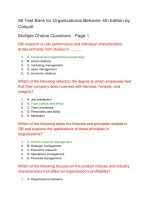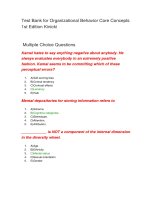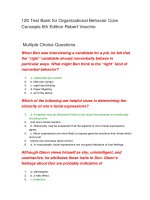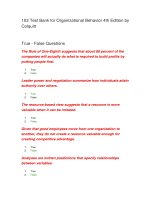Organizational behavior core concepts by kinicki chapter13
Bạn đang xem bản rút gọn của tài liệu. Xem và tải ngay bản đầy đủ của tài liệu tại đây (394.12 KB, 28 trang )
13
Organizational Behavior
core concepts
Organizational Design: How
a Structure Connects
Employees and Tasks
13-2
McGraw-Hill/Irwin
Organizational Behavior, Core Concepts
Copyright © 2008 by the McGraw-Hill Companies, Inc. All rights reserved.
Learning Objectives
• Define organizations and their basic
dimensions
• Explain commonly used metaphors for
organizations as closed or open systems,
military/mechanical bureaucracies, and
biological and cognitive systems
• Describe basic criteria for organizational
effectiveness
13-3
Learning Objectives
• Summarize what is involved in the
contingency approach to organizational
design
• Discuss new-style and old-style
organizations, including virtual
organizations
13-4
What is an Organization?
• Organization
– system of consciously coordinated activities
of two or more people.
13-5
What is an Organization?
• Four common denominators
– Coordination of effort
– Common goal
– Division of labor
– Hierarchy of authority
13-6
Designing Effective Teams
See an article from
Administrative
Science Quarterly
on designing
effective teams
13-7
What is an Organization?
• Unity of command principle
– each employee should report to a single
manager.
13-8
Organization Charts
• Organization chart
– boxes-and-lines illustration showing chain of
formal authority and division of labor.
13-9
Sample Organization Chart for a
Hospital
13-10
Figure 13-1
Organization Charts
• Hierarchy of authority
• Division of labor
• Span of control
– the number of people reporting directly to a
given manager
• Line and staff positions
13-11
Line and Staff Positions
• Staff personnel
– provide research, advice, and
recommendations to line managers.
• Line Managers
– have authority to make organizational
decisions.
13-12
Needed: Open-System Thinking
• Closed System
– self-sufficient entity, closed to the
surrounding environment.
• Open System
– organism that must constantly interact with
its environment to survive
13-13
Organizations as
Military/Mechanical Bureaucracies
• Bureaucracy
– Max Weber’s idea of the most rationally
efficient form of organization
• Weber’s Bureaucracy
– Division of labor
– A hierarchy of authority
– A framework of rules
– Administrative personality
13-14
Organizations as
Biological Systems
• The complex organization is a set of
interdependent parts which together
make up a whole because each
contributes something and receives
something from the whole, which in turn
is interdependent with some larger
environment
13-15
The Organization as an Open
System: The Biological Model
13-16
Figure 13-2
Organizations as Cognitive Systems
• Organizations have mechanisms to
interpret ambiguous events and to
provide meaning and direction for
participants
13-17
Question?
Which effectiveness criteria is the most
widely used?
A. Goal accomplishment
B. Resource acquisition
C. Internal processes
D. Strategic constituencies satisfaction
13-18
Generic Effectiveness Criteria
• Goal accomplishment
– most widely used effectiveness criteria,
measured by comparing key organizational
results with previously stated goals
• Resource acquisition
– organization is effective if it acquires
necessary factors of production
13-19
Generic Effectiveness Criteria
• Internal processes
– healthy system if information flows smoothly
and if employee loyalty, commitment, job
satisfaction prevail
• Strategic constituencies satisfaction
– Strategic constituency: any group of
people with a stake in the organization’s
operation or success.
13-20
Mixing Effectiveness Criteria:
Practical Guidelines
• Goal accomplishment
– approach is appropriate when goals are
clear, consensual, time-bounded, and
measurable
• Resource acquisition
– approach is appropriate when inputs have a
traceable effect on results or output
13-21
Mixing Effectiveness Criteria:
Practical Guidelines
• Internal processes
– appropriate when organizational
performance is strongly influenced by
specific processes
• Strategic constituencies
– appropriate when powerful stakeholders can
significantly benefit or harm the organization
13-22
The Contingency Approach to
Designing Organizations
• Contingency approach to organization
design
– creating an effective organizationenvironment fit.
13-23
Mechanistic versus Organic
Organizations
• Mechanistic organizations
– Rigid bureaucracies with strict rules,
narrowly defined tasks, and top-down
communication.
• Organic organizations
– Flexible networks of multitalented individuals
who perform a variety of tasks
13-24
Question?
In what type of decision making do top
managers make all key decisions?
A. Centralized
B. Decentralized
C. Fundamental
D. Primary
13-25









